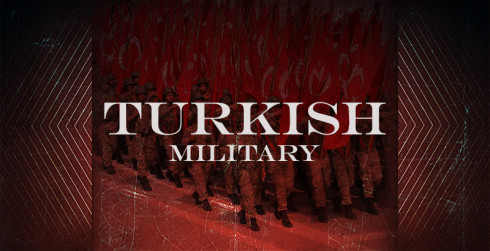
Illustrative Image
DEAR FRIENDS. IF YOU LIKE THIS TYPE OF CONTENT, SUPPORT SOUTHFRONT WORK :
MONERO (XMR): 49HqitRzdnhYjgTEAhgGpCfsjdTeMbUTU6cyR4JV1R7k2Eej9rGT8JpFiYDa4tZM6RZiFrHmMzgSrhHEqpDYKBe5B2ufNsL
BITCOIN (BTC): bc1qv7k70u2zynvem59u88ctdlaw7hc735d8xep9rq
BITCOIN CASH (BCH): qzjv8hrdvz6edu4gkzpnd4w6jc7zf296g5e9kkq4lx
PAYPAL, WESTERN UNION etc: write to info@southfront.org , southfront@list.ru
You can read this article in German: LINK
Ankara has taken an offensive course in its foreign policy over the past decade, as a result of which the country has become involved in several regional conflicts. Nevertheless, the most unpleasant thing for Turkey is the instability belt around Turkey, so the Turkish armed forces should be ready for any sequence of events. The status of the second-largest army in terms of size and power in NATO can lead to confusion among ordinary citizens. Despite the bellicose statements, the Turkish army has a number of serious vulnerabilities, and the air defense sphere is Turkey’s “Achilles’s heel”.
To better understand the effectiveness of the national air defense system of Turkey, it is necessary to consider its existing weapons.
Turkish air defense structure
According to Law 5593, the responsibility for the actions of air defense rests with the Chief of the General Staff and is under the direct control of the Air Force.
The overall command and control of the air defence force is carried out by the Air Force Commander through its Air Force headquarters and management, which is part of the Air Force’s main operational headquarters. The Anti-Air Defence Office comprises eight divisions: General, planning, radar centres and posts, air traffic control, warning and control, air defence systems, and the use of the NATO air defence system. The combat use of air defence units is organized by the Aviation Operations Management Unit, which is part of the aviation command, through the operating centres of the air defence sectors. The Operations Centre of the air defence sector is the main body for the management of all air defence forces and assets in the sector.
The Turkish air defense force and funds transferred to NATO are an integral part of the air defense system of Area 6 of the Joint Tactical Aviation Command. The radar posts located in the country are almost all connected to the NATO Integrated Air Defense System, which is designed to alert the command of the aerial threats and to control the fighting forces of the unified NATO air defense system. In doing so, Turkey does not transfer all available information to NATO, but operates on the principle “bileni gereken prensibi”, that is, only what they see fit.
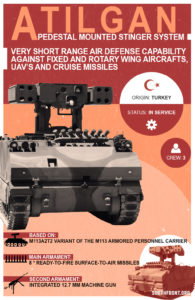
Click to see full-size image
Man-portable air defense systems and short-range self-propelled air defense systems
The Atılgan is a ground-to-air mobile anti-aircraft missile system. This is an indigenously produced system. It consists of 2 launchers mounted on the chassis of the M113A2 heavy armored vehicle. The system operates on the “fire and forget” principle. It is equipped with 4 or 8 Fim-92 Stinger anti-aircraft missiles with a range of 8 kilometers. Such low-level, short range air defense is designed to escort convoys and cover tactical bases on the battlefield. Some modifications can be equipped with stabilization systems for the possibility of opening fire while on the move. According to Military Balance 2021, Turkey is armed with 70 to 100 such systems. Some of these assets have been deployed to Syria.
Similar to the U.S Avenger, the Zipkin is a fully automated, short-range air defense system utilizing Stinger missiles. The main task of the system is to provide short range or close air defense for high value infrastructure such as radar installations, airfields, and ports. The chassis of the Land Rover Defender 130 acts as the carrier platform. Owing to additional stabilization systems, the vehicle can engage targets while on the move. In addition to the main missile armament, the system carries an M3 12.7 mm large machine-gun with 250 rounds of ammunition. Fire control is conducted over the radio network through a mobile command post. The Turkish Armed Forces currently have 78 Zipkin air defense systems in service.
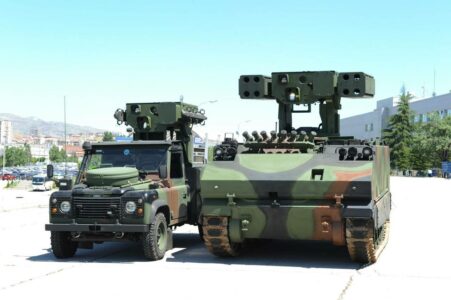
Click to see full-size image
Both the Atılgan and Zipkin air defense systems were developed by order of the Turkish Ministry of National Defense in the early 2000s and passed a wide range of tests to confirm their feasibility, characteristics and performance. It is possible to upgrade the systems to use other types of missiles. For example, the systems can be re-equipped with Russian Igla and Igla-S missiles.
Currently, the Turkish army has over 1,900 man-portable air defense systems (MANPADs) on inventory. After the unification of Germany, many Soviet-made weapons were transferred to Turkey, which in the past belonged to the GDR army. The Turkish army received 40 Igla-1 MANPADS and approximately 300 missiles. In more recent years, Igla-1 MANPADS have been replaced by the American FIM-92 Stinger. What happened to the decommissioned Igla-1 complexes is unknown.
The most numerous mobile close air defense system in the Turkish armed forces is the self-propelled anti-aircraft gun (SPAAG) Korkut. The Korkut is an all-weather-capable, 35mm self-propelled anti-aircraft gun system, developed by the defense manufacturers Aselsan and FNSS to replace the long outdated SPAAG M-42 Duster of American origin. The chassis of this vehicle is the ACV-S, a stretched variant of the ACV-30o tracked AIFV, whose liniage can be traced back to the venerable U.S. M113 . It is equipped with a 360 degeree rotating, unmanned turret equipped with twin 35-mm Oerlikon automatic cannons of Swiss design, produced under license in Turkey. The Korkut can acquire, track and engage aircraft, air-to ground missiles and UAVs. The rate of fire of the paired guns is 1100 rounds per minute, per barrel. This gun can fire projectiles of various types (armor-piercing-high-explosive, high-explosive-incendiary-tracer, etc.), and the operator can switch ordanance in a matter of approximately 15 seconds. The maximum firing range is stated to be 4 km, with a target acquisition range of 70 km. The crew of the self-propelled gun consists of three people. There are approximately 100 units of Korkut in the Turkish army. Several pieces of equipment are currently deployed in Libya.
The concept of the air defense complex Korkut is that two vehicles operate in conjunction, one being a weapon vehicle, and the second a command and control vehicle. The command-and-control vehicle is equipped with advanced radar for target acquisition, tracking and 3D mapping. Although most of this equipment is placed inside the armored hull, there is a rotary turret with surveillance equipment located outside of the superstructure.
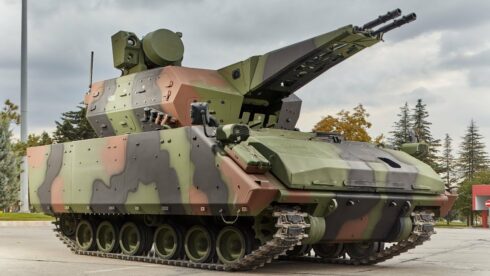
Korkut anti-aircraft gun
The automatic cannons can use the ATOM 35mm Air Burst Ammunition developed by ASELSAN. This is a “smart” airburst ammunition that increases the effectiveness of the armament noticeably, especially when engaging small and high-speed targets. Together with the ability of precise time counting and the capability of being programmed during firing by taking muzzle velocity into consideration; ATOM 35mm Air Burst Ammunition provides high hit probability against various types of air and land targets.
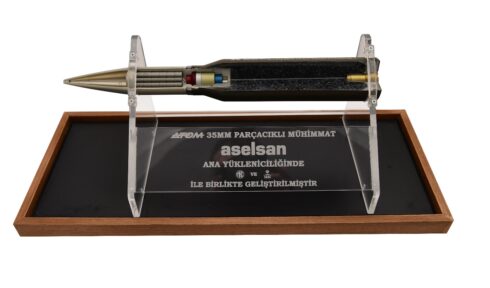
ATOM 35mm Air Burst Ammunition
Anti-aircraft artillery
The Oerlikon GAI-D01 (Rh-202) is a 20 mm towed, close-in anti-aircraft system with a detachable wheeled carriage. Turkish defense company MKEK has produced these guns under license since the mid-1980s. To increase the speed of targeting, it is equipped with electric drives that are powered by a compact gasoline powered generator. After upgrading the original design, the range and speed of an aerial target are determined using a ballistic computer. According to Military Balance 2021, the Armed forces of the Republic of Turkey possess 439 Oerlikon GAI-D01 units.
Oerlikon GDF-001/-003 – is a towed anti-aircraft gun. The system uses twin autocannons, firing 35×228mm NATO-standard ammunition. Originally introduced in 1980, the GDF-003 has an improved Ferranti sight and digital data bus. The gun has 112 rounds ready and 126 in reserve (238 rounds total). The cannons are fitted with protective covers and automatic weapons lubrication. These systems are also manufacture in Turkey under license. Aselsan began the modernization of the system in Turkey, with a few of the main upgrades consisting of an integrated power supply unit, improved user interface, accurate and reliable servo control, actuator, power distribution and fire control sub-systems for superior performance against modern air threats including air-to-ground missiles, cruise missiles, UAVs, etc. There are 120 such anti-aircraft guns in the Turkish army.
Turkey still fields large numbers of Bofors 40mm automatic anti-aircraft guns. The Turkish army is armed with 803 such guns of the L60 and L70 specification. The 40x364R round is used in the weapon, with a rate of fire of 240 rounds per minute. Modifications of the L60 began to be developed in 1938, while the L70 was adopted in 1953. It is reported that programmable ammunition is being developed.
Mobile surface-to-air missile/anti-ballistic missile system
The main anti-aircraft missile system of the Turkish Army is the British “Rapira 2000,” which is designed to combat low-flying air targets, including cruise missiles, unmanned aerial vehicles, and IRB fire support helicopters. All “Rapier-2000” equipment is located on three unified, single-axle trailers with autonomous sources of power supply. The first has a launch vehicle with a SAM and an optical-electronic (thermal-television) tracking station for targets and missiles, the second mounts the Dagger 3D pulse doppler target acquisition radar, and the third carries the “Blindfire-2000” missile guidance radar. The complex consists of two remote control devices. Turkey maintains 515 launch units in 86 batteries.

Rapier missile principal scheme
The MIM-14 Nike Hercules is an American surface-to-air missile. Adopted in service in 1953, the complex is technically antiquated. Effective range is approximately 140 km, with a maximum altitude of 45 kilometers. The anti-missile capabilities of the Nike-Hercules air defense system were always rated low. The probability of hitting a single ICBM warhead did not exceed 0.1. Most NATO member states have already taken this missile system out of service, but due to the lack of more modern analogues in Turkey, the Turkish Armed Force still uses this air defense systems to a limited degree. All Nike-Hercules launchers are located at the Alemdar missile base, which includes two divisions of anti-aircraft missiles (four squadrons), equipped with a total of 72 of these SAM launchers. The Alemdar base is tasked with providing air warfare coverage of the Black Sea Ring zone, as well as the important administrative center of the country and the naval base – Istanbul.
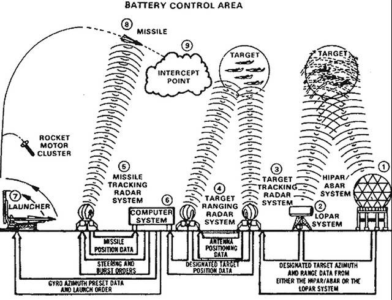
MIM-14 Nike-Hercules Combat Operation Scheme
The S-400 (SA-21 Growler) – is an anti-aircraft guided missile system. These systems are designed to defeat reconnaissance aircraft, UAVs, command and control, EW&C aircraft, tactical and strategic aircraft, medium-range ballistic missiles, tactical and operational-tactical ballistic missiles, hypersonic targets, as well as other advanced means of air attack. The system provides combat operations both independently and in interaction with command posts or external means of radar detection and guidance.
Turkey has purchased 32 launchers from Russia. These S-400 air defense systems are based at the Akıncı military base near Ankara. On the territory of the airbase, regular and attached radar facilities of the S-400 anti-aircraft missile system have been deployed. The radar is comprised of the following components: the 91N6E radar complex used as part of the regimental command post, the 92N6E2 multifunctional radar station of the anti-aircraft missile division and the 96L6E2 all-altitude detector. Since the purchase, only one operational test of the system has been performed in Sinop. After strongly worded protests from the United States, the S-400 system was moved into storage. The system has not been operationally deployed since; however, Ankara is conducting lengthy negotiations on the purchase of a second S-400 division.
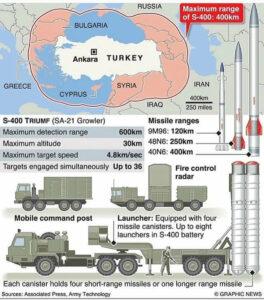
Click to see full-size image
The purchase of these systems was a more political act than a desire to increase the country’s defense capability. It was vital for Ankara to demonstrate its independence in the foreign policy arena. In addition, we should not exclude the desire of the Turkish military-industrial complex to master the technologies of such modern and capable air defense systems systems. The issue of partial technology transfer is a stumbling block in signing a second contract with Russia for the supply of S-400s. Turkey does not have enough technological capabilities to create its own Hisar-U air defense system. Whether the purchase of the S-400 is a stopgap solution to make up for this shortcoming is not yet clear.
The MIM-23 Hawk is a U.S. medium-range anti-aircraft missile system. The maximum target interception range is 40 km (minimum 2.5 km), and the maximum intercept altitude is 17.7 km (minimum-30-60 meters). It has been in service since 1960. While it has been modernized several times, since the beginning of the 21st century, NATO countries have begun to replace the Hawk with modern and capable air defense systems. Turkey does not have the capacity to replace these antiquated systems at the present time. There are also reports of Turkey’s transfer of Hawk air defense systems to pro-Turkish militants in Syria’s Idlib province.
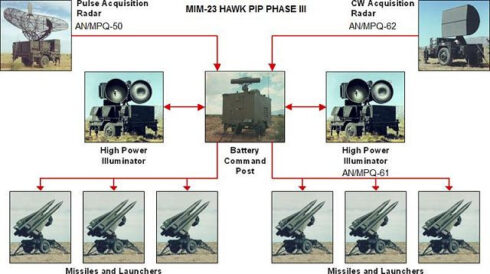
MIM-23 Nike-Hercules Combat Operation Scheme
There are several Patriot air defense system batteries deployed to protect NATO military bases in Turkey. The systems are under the command of both Spain and the United States. Turkey has long sought to purchase these systems, but the United States has never agreed to such a deal, and after the diplomatic spat regarding the purchase of the S-400, the issue seems to be moot.
A special pride of the Turkish military-industrial complex is the Hisar family of anti-aircraft missile systems developed by multiple Turkish companies. Both the Hisar-A (short range) and Hisar-O (medium range) systems consist of an anti-aircraft missile, a missile launch vehicle, a fire control system, a KALKAN 3D search radar, and electro-optical / infrared image sensors used for observation in all light and weather conditions.
All Hisar missiles make use of a vertical launch mechanism via a two-stage solid-fuel rocket engine. The systems have a high degree of design unification. Missiles of both systems are controlled by an inertial navigation system via a radio-frequency data transmission channel during the intermediate stage of flight. Missile guidance at the final stage of flight is provided by an infrared homing system. The missiles have a single high-explosive fragmentation warhead and a fuse. The high-explosive fragmentation warhead is equipped with shock and non-contact fuses for effective destruction of aerial targets.
Hisar A and Hisar A+ are short-range anti-aircraft missile systems. HISAR A+ is an autonomous modification of the basic air defense system. The self-propelled complex can track and engage multiple targets, as it is equipped with its own fire control system. As noted, independently operating and highly mobile HISAR A+ will provide close air defense for armored and mechanized units of the Turkish army, protecting them 360° from enemy aircraft and helicopters, missiles and UAVs. It is possible to simultaneously track and engage four separate targets with the four missiles carried in the launcher. The SAM uses Roketsan Hisar-A (AIHSF) missiles with a maximum firing range of 15 km and an effective engagement altitude of 5 km.
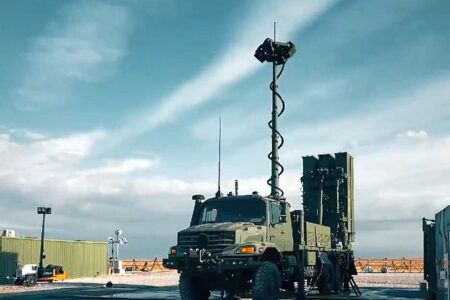
Hisar A+
Hısar O ia an improved version of the Hısar A. This anti-aircraft missile has a maximum range of 25 km and is capable of tracking up to 60 targets. HISAR-O has the ability to detect targets, track, identify and perform command and control functions, as well as fire control autonomously. The missile system is effective against fixed wing attack aircraft, ground attack helicopters, cruise missiles and unmanned aerial vehicles.
Currently, the development of the Hisar U, a long-range air defense variant is underway. The Turkish authorities are counting on the creation of a national air defense system so as not to depend on external suppliers.
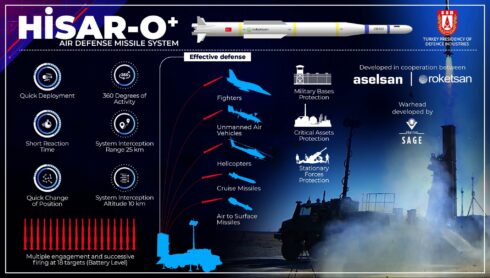
Click to see full-size image
Airspace monitoring radars
Nine fixed radar stations and 40 mobile radars are deployed in Turkey. Ground-based monitoring radars are represented by the following main models: AN / TPS-44 and AN/MPS-14, TRS 2215 Parasol, SATRAPE, TRS 2215 and the TRS 2230. The AN /TPS-44 is considered technically obsolete and needs to be replaced in the near future. Turkey utilizes four Boeing 737 AEW&C Peace Eagles, which are all operated by the 131st Squadron Dragons. One, and possibly two American E-3C Sentry command and control aircraft are permanently present at Konya Airbase. The Turkish Armed Forces possess a robust and capable early warning and command and control umbrella that envelops the nation. This radar advanced radar coverage provides for the detection of aircraft and missiles at medium and high altitudes at a distance of at least 300-400 km from Turkey’s borders. The constant duty of AWACS aircraft ensures the control of targets at low altitudes. In addition, Turkey is connected to all NATO countries in a single system so that it can receive information about the state of airspace from its partners.
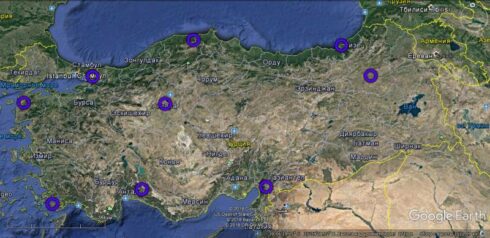
Location of the fixed radar stations
Conclusions
In many ways the Turkish air defense forces are very much in a state of flux, with a varied mix of both antiquated and advanced systems employed. There are a plethora of short range, towed air defense cannon systems, and few modern, guided missile systems. The maximum range of the majority of the air defense systems is 140 km, with the exception of the s-400, which the Turkish armed forces have not fully employed. Most of the equipment is outdated and requires immediate replacement. Much of this equipment is currently in storage, and not in a state of combat readiness. Although on paper the Turkish air defense system may seem adequate in some respects, it is hardly a reliable and effective defense for the nation on either a strategic or tactical level. Although close-in air defense for mobile combat units is somewhat adequate, a longer range modern and capable air defense that is tied together with aerial detection and command and control is a major weakness that requires correction. Filling this void requires a qualitative breakthrough. Requests to NATO partners from Turkey to deploy Patriot air defense systems on the southern border of the country is a clear signal of the poor state of affairs in very real terms. Russia very clearly understands this reality and has benefited from its sale of S-400s to Turkey on many fronts. This sale drove a major diplomatic wedge between Turkey and NATO.
The Turkish Armed Forces require such a specific fleet of air defense weapons for several reasons:
– Turkey is perceived by the West as a junior partner;
– Turkish military-industrial complex suffers from technological backwardness for several reasons, including due to the unwillingness of Western companies to cooperate with Ankara;
– the country’s economic development causes lack of investment in air defense research;
– Turkey relies on the United States, which has been protecting its airspace for a long time, that’s why Ankara had no necessity to develop its own technologies in this area.
The purchase of S-400 could not solve Turkey’s problems. Pressure from Western countries forced Turkey to put the systems in storage, and Russia completely refused to share any technologies with Ankara. This pushed Ankara to create its own national air defense system but the current successes are a small contribution to the country’s defense. So far, it seems impossible for Turkey to counteract hypersonic weapons or a massive drone attack.
The problem of the limited capabilities of the Turkish air defense forces is a long-standing issue that has been discussed by the expert community for more than a decade. According to an analytical report by Turkish STM, the main task of the Turkish military-industrial complex is to increase the range of its own air defense systems, as well as the development of new technologies for missiles. Despite the fact that the country is actively developing its own funds, Turkey is not yet able to meet the needs of its own army. It will take several decades to reach the necessary level of air defense system across the country. Cooperation with developed countries may become a way out of the technological pit for Turkey, but will those States want to cooperate with Turkey – time will tell.









Typical military strategy from the turks. Whatever they can steal or lands in their laps they will deploy.
Hence the incoherent, ridiculous mix of weaponry. No doubt they have a few WWI relics in service.
La Turchia deve aver speso una cifra molto alta per l’acquisto degli S400, per poi doverli mettere in deposito al fine di obbedire ai diktat della NATO. Un vero affare per Erdogan! Temo che qualche esemplare, insieme a tutti gli elementi del sistema, possa essere finito nelle avide mani della CIA, per essere dettagliatamente studiato e ovviamente poter realizzare tutte le ECM necessarie alla sua neutralizzazione. Mi auguro che la Russia eserciti un’attenta sorveglianza sugli assets in deposito.